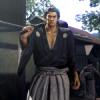The Yakuza series of action-adventure games, known as Ryuu Ga Gotoku in Japan, stands out for being one of the few videogame franchises out there that deals with the yakuza and a (sort of) realistic modern-Japan setting. This setting and the J-drama-esque intersecting character ties play no small part in why it’s developed such a dedicated, albeit small, fanbase in the West.
We don’t know much about the recently announced Yakuza game, other than that it will be a cross-generation game for both PlayStation 3 and PlayStation 4, that it won’t be a spin-off in the vein the excellent Meiji-era Yakuza Restoration, and that the developers are setting out to create a game that men - particularly older men such as the aging development team, can enjoy - so bromance is probably still on the table, and the fact that around half of all gamers are women is continuing to be ignored.
I’ve talked at length before about my problems with the as-of-yet unlocalized Yakuza 5 and celebrated Restoration for rectifying most of my grievances with the series. I believe the upcoming Yakuza game could stand to learn lessons from both of them.
5. Localization
This should go without saying, but only five of the ten Yakuza games released so far have gotten English translations, so…
Unlike some other companies, all of Sega’s localization is done in-house. This theoretically means more consistent translation, but it also potentially diverts resources away from the development of the new Japanese releases that are the real moneymakers.
Many have expressed hope that Sega’s recent acquisition of Atlus, a developer-publisher well known for localizing its niche titles, could mean a change. Perhaps they could give the translation to an Atlus team, allowing series developer Ryuu Ga Gotoku Studio free to concentrate on game development.
But I’m not so sure that Sega’s reluctance to release another Yakuza in the West is a matter of resources. The publisher has been sitting on the Japan-exclusive Ryuu Ga Gotoku 1 & 2 HD Edition (PS3/Wii U), a HD collection of the first two Yakuza games – two games that have already been translated into English - for quite some time now. Some 20 months after the Japanese release, the HD collection has yet to materialize in the West.
So what is Sega’s problem? Only they can answer that, but if a growing number of vocal Western fans are to be satisfied, it’s clear that the publisher’s approach to localizing the series needs to change.
4. One playable protagonist
Over the years, the number of playable protagonists in the Yakuza games has fluctuated from anywhere from one to five. The new Yakuza should only have one, as introducing multiple characters brings a host of narrative and pacing issues along for the ride.
Take the eating-out mechanic in the later Yakuza games, where characters can visit eateries for temporary buffs. The mechanic is sound, but there’s still the lingering issue of how to introduce the mechanic to each character, as each one needs a narrative explanation for how they came upon it. That means long-winded, contrived justifications and tutorials that inform the characters, rather than informing you.
The series history shows multi-perspective narratives isn’t RGG Studios strong suit; this is particularly the case with Yakuza 5, where some character stories are almost irrelevant to the big picture, not that interesting, or both. It might be more reasonable to expect a one-character narrative than for the developer to vastly overhaul their writing standards.
But wouldn’t stripping the playable cast down reduce the number of fighting styles? The unlocalized PSP spin-off Kurohyou (“Black Panther”) might have a solution to that; the protagonist of that game is able to learn and develop multiple fighting-styles from kung-fu to boxing, each style with its own set of skills to learn.
Better yet, if you can switch between styles on the fly, as is possible in Restoration, then your options increase, creating a deeper battle system whilst simultaneously cutting down on narrative and explanatory fat.
3. Kaoru Sayama
Almost every major Yakuza character was recast in Restoration but Yakuza 2’s yakuza-hunting detective Kaoru Sayama was conspicuous by absence. A short appearance in Yakuza 3 notwithstanding, she’s been missing for a very long time; a shame because her sassy attitude and chemistry with Kiryuu was one of the best parts of Yakuza 2.
The developers have already expressed that they want to create a game for men. But they should consider the benefits of a female presence within Yakuza’s distinct story-telling style. Keep in mind that Yakuza celebrates the romanticism of masculinity, to the point where the characters are so exagerratedly macho that the entire thing descends into levels of homoeroticism which often makes the series feel like a parody of itself.
It’s why in a game where 4 tough dudes get together to take down one bad guy, they end up squaring off against antagonists of their own, rather than teaming up against one guy; they show respect for each other by allowing each man to fight his own battles, even when the odds are against him. You couldn’t have a Yakuza game without brooding dudes and their implicit codes of honor.
But this focus on the romance of masculinity introduces narrative and mechanical limitations that a character like Kaoru can get around – she’s not bound by a bro-tastic code of honor and her position as a police officer gives her all the reason she needs to interfere with yakuza business from the outside-in. Yet she’s still able to kick enough ass that she can still join Kiryuu and friends in laying a beatdown on the Japanese underworld.
Kaoru is positioned perfectly to add a human touch to the story, reminding us of what it’s like to be a non-yakuza caught up in yakuza politics, and her role as a police officer means her involvement in the story wouldn’t simply be tangential as has often been the case with Haruka. It’s a combination that opens up potential for the sort of co-op action which was glimpsed fleetingly with Yakuza 2’s co-op Heat attacks.
2. Grow some narrative balls
Between the first two Yakuza games, protagonist Kazama Kiryuu goes from being one of the most notorious gangsters around to washing his hands of a life of crime and easing into his role as a father figure. It’s a change set in motion by the death of his own father figure and mentor – the after-effects of which can be felt throughout the series. That event is one of the few influences that series canon hasn’t undone in some way.
In Japan at least, the timeline in the series has progressed one-to-one with the passage of time in real life. Haruka was 7 years old back in 2005 when the original Yakuza was released; by the time Yakuza 5 was released in 2012 she was going on 16, having aged the same amount between each installment as there was time between them.
The games’ setting, Kamurocho, and its inhabitants are a rare example of a living, breathing world that doesn’t’ suffer from Bart Simpson syndrome. But without plot developments to irreversibly change Kamurocho the Yakuza series is in danger of becoming stunted in its own way - through episodic story telling.
The series has taken some exotic turns over the years, most notably in Yakuza 5 when Haruka had a stint as a pop-idol, Kiryuu struggled with living alone and one character was “killed off”. All major shake-ups that were undone through plot contrivance, making a lot of the games’ events feel self-contained.
For the next Yakuza I’d love to see events set in motion that would change the status quo indefinitely, leaving me dying to find out what happens next.
1. Simulation
Yakuza’s world is alive in its own way, but the series could go one further by upping the ante on its simulation. “Simulation” being a catch-all for everything that makes Yakuza’s world behave and respond convincingly, making it immersive even if it isn’t entirely realistic.
Ideally that would mean no more load times between indoor and outdoor areas, NPCs that have schedules and places to get to rather than acting as obstructive semi-tangible holograms, smooth integration of different gameplay styles into exploration sequences and consistent production values between cutscenes and gameplay.
These are all areas were Yakuza has strived to make improvements, the series has come a long way from when it first migrated to the PlayStation 3 with Ryuu ga Gotoku: Kenzan!, where the gap between cutscenes and in-engine was jarring. And Restoration saw chase sequences and battles integrated relatively smoothly into the flow of the main game, something made possible by engine-improvements and the PlayStation 4’s muscle.
But there’s still a lot more that can be achieved; even Restoration suffered from simulation quirks such as NPCs unable to navigate around you if you were locked in conversation, they’d just collide into you and dissipate as if they were made of imagination flakes. And having a group of blood-thirsty bandits chase after you only to vanish if you stopped to pick up fallen change was comically archaic and prone to player abuse.
RGG Studios has made revisions to the series’ simulation over the years making this less an issue of “if” than “how much”, as in “how much” can they realistically improve simulation complexity when the next entry into the series is going to be a cross-generation game? Here’s hoping that RGG Studios aren’t shy about putting out true “next-gen”-feature rich version of the next Yakuza game for PlayStation 4 owners. One can dream, right?
Ultimately I guess what anyone wants out of a Yakuza game is for them to be keep getting better; deeper combat, varied casts, powerful plot developments and an ever more immersive world. But I think the above changes are, for the most part, both realistic and in line with the tone and style of the series. Except maybe the localization part… anything could happen with that.






